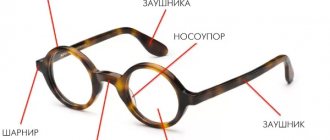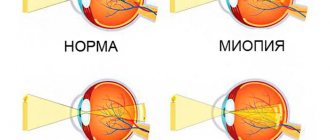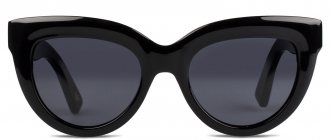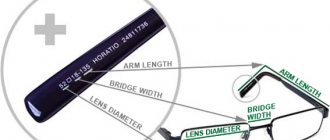Let's look at the types of the most popular sun lenses and discuss their advantages and features.
- More than a fashion accessory
- Types of Prescription Sun Lenses Tinted Sun Lenses
- Polarized lenses
- Painted lenses
- Essilor
A significant part of the population of our country uses corrective glasses. Most users have at least two points, and some have more. For many, corrective glasses are essential in everyday life. However, having these glasses with sun lenses is also necessary, and in some cases - even extremely important when being outdoors and engaging in activities such as fishing, driving, cycling, golfing, etc. . Let's look at the types of the most popular sun lenses and discuss their advantages and features.
Why do you need prescription sunglasses?
Modern man is forced to constantly strain his vision, as a result of which it worsens. Contact lenses are not suitable for everyone, so they cannot give up glasses. But in sunny weather, another problem arises - they do not protect against rays, glare, reflections, and flashes hitting the eyes. To solve this problem, we can recommend sunglasses with diopters.
Not everyone can wear contact lenses or undergo vision correction surgery for various reasons; sunglasses with diopters in this case are a solution to two problems at once
They have many advantages:
- versatility (glasses are suitable for those suffering from myopia, farsightedness, and astigmatism);
- clearer and more contrasting perception of objects;
- less eye fatigue due to reduced intensity of exposure to ultraviolet radiation on the retina;
- the ability to concentrate longer, less influence of distractions (glare, reflections);
- affordable price (glasses will cost about the same amount as regular corrective glasses).
The main disadvantage is that some glasses are not suitable for all occasions. The sun's brightness level is constantly changing. The solution may be models with several different overlays or “chameleons” with varying degrees of darkness. The latter also have their own characteristics - in the cold they will darken faster than in hot weather; behind glass (for example, car glass) they will not darken at all. Photochromic ability is lost over time.
An interesting option is sunglasses with clips. The kit includes one or more pads that allow you to quickly turn regular glasses into dark ones. When choosing such a model, be sure to check the reliability of the fastenings, how freely the lenses move (they should neither get stuck nor fall out), and the exact correspondence of the size and shape of the frame to the pads.
There may be one or two or more sun protection pads for glasses frames.
Video: testing sunglasses with pads
More than a fashion accessory
Over the past years, manufacturing companies and specialists in the field of optical retail have never tired of repeating that sunglasses are not just a fashion accessory that matches the style of the wardrobe and creates a fashionable image. Sunglasses play an important role in protecting the eye from harmful ultraviolet (UV) rays of the solar spectrum, long-term exposure to which leads to a number of eye diseases - cataracts, macular degeneration and many others. However, data from a study conducted by Carl Zeiss showed that out of 2 thousand people surveyed, 28% did not suspect that UV radiation is dangerous in winter, and 10% were sure that it does not affect the eyes in cloudy weather. The study also shows that when choosing sunglasses, more than half of participants are guided by the accessory's compliance with fashion trends and comfort, rather than by the level of eye protection. A third of respondents were unaware that exposure to ultraviolet radiation is associated with the risk of cataracts and other diseases. According to a survey conducted by UK marketing research company OnePoll, which specializes in online and mobile data collection methods, only a third of eyeglass wearers know what level of UV protection their glasses have. Recent industry standards require ultraviolet to be cut off at a wavelength of 380 nm, but the world's leading health organizations recommend moving this limit to 400 nm. While 20 nm may seem like a small difference, this range accounts for 40% of all radiation hitting the Earth that can affect eye health. Modern sunglasses must provide complete cutoff of UV radiation, reduce the brightness of visible light, including partially blocking the entry of blue rays to the eyes, the influence of which is associated with the risk of damage to the retina. Sunglasses are recommended for everyone, but especially for children. Scientists have found that more than half of the total dose of UV radiation affecting the eyes that a person receives throughout his life accumulates by the age of 18.
How to choose glasses for yourself
For any glasses, go only to specialized optical shops. Shopping at disreputable retail outlets can dramatically worsen vision problems. It is impossible to assess the degree and quality of ultraviolet protection by eye, so do not hesitate to check the availability of certificates confirming the accessory’s compliance with certain ophthalmological standards.
It is problematic to purchase ready-made sunglasses with diopters that are suitable for you in all respects. Manufacturers simply cannot provide a wide range of models of different designs with lenses of different functionality, darkness levels and diopters. It is much more convenient to make them to order by choosing the frame you like and inserting the lenses you need into it. This must be preceded by a consultation with an ophthalmologist. It is available in most salons. The specialist will select the type of lenses and diopter power, taking into account the needs, condition of the visual organs, and age of each client.
Some salons also offer services for replacing and/or tinting lenses in existing frames, but this is not always possible due to their design features (large diameter, strong bending) or large lens wear, which will only emphasize its darkening.
What else to pay attention to when purchasing:
- The more famous the brand, the higher the quality of the accessory. But at the same time, the risk of purchasing a counterfeit increases and the price increases. To avoid purchasing a fake, you can go to the manufacturer’s website and find out what the original should look like.
- Film coating is not the best option. It wears out quickly and peels off easily. It lasts for a few months at most.
- Rimless and semi-rimless frames will not support the weight of thick and fragile glass lenses.
- When wearing glasses, make sure that the lines and proportions of objects in the field of view correspond to real ones, and when looking at the sun there is no need to squint.
The choice of frame shape, color and model is a secondary matter. Here are some recommendations common to men and women, determined by face type:
- Oval. Fits almost any frame. With strongly pronounced cheekbones, wide, bright glasses with thickened temples at the temples look good.
- Square. Choose from round or oval frames with wide lenses. They should be neither too thin nor too massive. Half frames look good with an emphasis on the upper part.
- Round. Give preference to fairly wide frames with lenses in the shape of a rounded rectangle or trapezoid. But the cheekbones should not be closed. Unusual accents are welcome - bright details, other designer finds.
- Triangular. An elegant, but rather massive frame with rectangular or oval lenses and an emphasis on the upper part is suitable.
The range of frames for sunglasses is very wide - you can choose models that harmoniously combine with any type of face
Video: glasses frames suitable for different face types
Types of Prescription Sun Lenses
The main types of prescription sun lenses (prescription sun lenses) that combine optimal vision correction and eye protection are tinted and polarized lenses. Let's consider their principle of operation and features.
Tinted sun lenses
Tinted lenses reduce the amount of light reaching the eyes due to the presence of absorbing dyes. The optical density level of these lenses (the reciprocal of light transmission) is directly proportional to the concentration of the dye or dyes.
Dyes may be contained in the surface layer of lenses - such sun protection lenses are obtained by coloring lenses made from materials based on CR-39 in dye solutions at elevated temperatures. Dyes can be distributed in the lens material - thus obtaining sun-protective afocal lenses. Making prescription lenses, especially high-power lenses, from preforms with volumetric dye distribution can result in different optical densities at the center and periphery. Dyes may be contained in a coating on the surface of the lens - in this case, it must be made of a material that can be dyed in dye solutions or contain distributed dyes. Currently, manufacturing companies offer a wide range of colors of tinted lenses, but the most popular ones for sun protection are gray and brown and their shades. The color of the lenses does not affect the level of protection, and its choice is determined by the preferences of the buyer. Brown lens color is perceived as warmer and may enhance the contrast of some environmental colors but distort others. Gray color is more neutral - such lenses uniformly reduce light transmission throughout the entire visible range of the spectrum and provide more natural color rendition.
Manufacturing companies offer a wide range of tinted lens colors
Tinted lenses can be produced in different optical densities according to customer preferences. The choice of color intensity and its type (uniform or gradient) affects the degree of protection from bright light: lightly colored lenses (light absorption is 25%) provide less protection than strongly colored lenses (75%). For maximum protection from excessive sunlight outdoors, lenses with 75% light absorption are recommended. Regardless of the intensity of staining, lenses must guarantee complete protection from UV radiation, which is achieved through additional processing in solutions of UV absorbers, the introduction of these absorbers into the lens material, and the application of additional coating.
Increasing (from left to right) optical density of tinted lenses
Holders for gradient lenses
Polarized lenses
Polarized eyeglass lenses have been growing in popularity over the past 10 years and have become increasingly preferred by people involved in a variety of outdoor activities. The basis of every polarizing lens is a polarizing filter film. Polarizing filters are produced by heating and stretching an organic film of polyvinyl alcohol or polyvinyl acetate, causing its molecular structure to be oriented parallel to the direction of stretching. The film is then passed through a weak solution of iodine, the molecules of which diffuse into oriented molecular chains, forming a polarizing filter. With its correct orientation, it allows you to completely cut off plane-polarized light, which is formed when the light flux is reflected from extended surfaces - ice, snow, wet road surfaces. It is plane-polarized or linearly polarized light that causes glare, which reduces image contrast, makes it difficult to distinguish colors and adversely affects visual acuity. Polarized lenses relieve eye strain in adverse lighting conditions, improve image contrast, color perception, and even the reaction of the glasses wearer.
Polarized lenses improve image contrast and color perception
There are several methods for producing polarized lenses and their blanks: lamination, stamping, injection molding and polymerization in a mold. Lamination is the oldest method and is how the first polarized mineral glass lenses were produced. A similar method is used to produce lenses based on organic materials, for example CR-39. When laminating, a polarizing film is placed between two plates that form a finished lens or semi-blank.
Polarized lenses brighten colors in harsh light and glare conditions
Stamping is used by some companies in the mass production of afocal polarized lenses for sunglasses. A more modern technology for the production of corrective polarized lenses and their blanks involves placing a polarizing film in a mold, into which a liquid monomer mixture or a polymer melt is then fed. After polymerization or hardening of the material, the film becomes an integral part of the lens, which provides high adhesion and helps avoid delamination of the polarized lens. Younger Optics uses its own technology for manufacturing corrective polarized lenses from polycarbonate: a polarizing film is placed on the front surface of the lenses, and a hardening coating is applied directly to it. These lenses feature improved polarizing performance due to the fact that there is no polycarbonate layer on top of the polarizing filter while maintaining high impact resistance. Today, polarized lenses are available in different colors, but the main ones are gray and brown.
Products of popular brands
Many brands produce high-quality sunglasses:
- Ray Ban. Almost the standard of sunglasses. The models are invariably stylish, the frames are distinguished by carefully adjusted shape. Hypoallergenic and wear-resistant materials are used for their production. This is combined with high quality lenses and reliable ultraviolet protection. The model range and palette of possible shades are very wide (up to 55 options).
- Polaroid. Another almost legendary brand. The manufacturer focuses on high-quality polarization; the lenses are produced using a unique patented technology that provides absorption of ultraviolet rays, improved scratch protection, increased strength and flexibility. The glasses are very comfortable and reliable, there are many frame design options.
- Fendi The brand focuses on the sophistication of design and unique style, but the quality does not suffer. For the manufacture of frames and lenses, wear-resistant hypoallergenic plastic is used, which provides reliable protection against ultraviolet radiation. The set includes a case.
- Prada. A brand whose accessories have long established themselves as invariably fashionable, high-quality and slightly extravagant. Sunglasses retain their presentable appearance for 7 years or more. The model range is quite wide. Plastic lenses provide protection against photoaging.
- Oakley. Glasses ideal for sports. The frame is highly impact-resistant and wear-resistant, the lenses reliably protect from ultraviolet radiation and bright sun, and provide visibility without distorting the contours and proportions of objects. At the same time, the glasses are very light, you hardly feel them on your face, and thanks to the special coating they do not slip on sweaty skin. The kit includes a case and several pairs of interchangeable lenses with varying degrees of tint.
- Bradex. A whole multifunctional kit. The set includes five pairs of lenses, 1-2 frames, two cases and a lanyard. You can “collect” different accessories, focusing on the weather and your own activity. All lenses provide reliable UV protection; high-quality plastic or rubber are used for frames.
Photo gallery: prescription sunglasses from famous manufacturers
“Wayfairs” from Ray Ban are a kind of “classic of the genre” in the world of sunglasses
"Aviators" from Ray Ban - the choice of many world celebrities
Ray Ban glasses have already become timeless classics; the model range allows everyone to find their own option, regardless of gender and age.
Polaroid glasses are high quality and reliable UV protection at a relatively affordable price
The Polaroid brand offers consumers a wide range of lens shades
Leopard print motifs have not gone out of fashion for several years - this is also reflected in the frames of Polaroid sunglasses
Even just trying on some Fendi glasses requires a certain amount of courage.
Fendi glasses come with a branded case and a microfiber cloth
The gradient in Fendi glasses looks very stylish thanks to the frames
Gradient mirrored glasses from Prada protect the delicate skin of the eyelids from photoaging
Prada glasses can look surprisingly classic
Prada is in no hurry to abandon metal frames
Oakley glasses are the choice of many professional athletes
Oakley glasses are functional without sacrificing style.
The Oakley Jawbreaker Photocromic Polished glasses are definitely futuristic.
Bradex glasses allow you to have a new model for every day that is most suitable in terms of functionality
Bradex glasses in any version invariably provide high quality protection from ultraviolet radiation
Advantages and disadvantages
Let's compare the advantages and disadvantages of tinted and polarized sun lenses.
Painted lenses
Advantages: A wide variety of color shades and color intensity levels, up to obtaining the color according to the customer’s sample. Certain colors can provide a competitive advantage to athletes in a number of sports. Possibility of fashionable, including two-color, gradient coloring. The greater the color intensity, the greater the degree of protection from excessive sunlight. Create a stylish image combined with eye protection. Depending on the chosen color, the user of glasses can create any look - fashionable, extravagant or neutral. Simplicity of coloring technology, especially CR-39 based lenses. To ensure uniform coloring, the lenses are immersed in a hot solution with dye and kept for a certain time to obtain the desired optical density. Gradient coloring is achieved by dipping the lens holder into or out of the solution. When using gradient staining, you should pay attention to the correct placement of the lenses in the holder if they have an astigmatic component. Low price with the possibility of coloring lenses of various designs - single vision, bifocal, progressive. Flaw. Tinted lenses do not protect the eyes from plane-polarized light. The light transmittance of conventional high-optical-density sunglasses, painted on the surface or in the bulk, or with light-absorbing coatings, is 15–20%. They protect the eyes from excessive brightness of solar radiation, but only partially from bright reflected glare. Compared to normal sunlight, reflected light is more intense, so tinted sun lenses are not enough to provide visual comfort to the wearer.
Polarized lenses
Advantages: Improved visual clarity and contrast in conditions of excess plane-polarized light and glare, which is formed when reflected from water, wet asphalt, sand, snow, ice, car bodies. Increased comfort - in the absence of interfering reflected light, the eyes do not need to adapt to it, therefore, they are less strained and tired, so they can better recognize objects in conditions of excess lighting. Optimal color rendering - polarized lenses not only do not distort colors, but even make them brighter in conditions of excessive lighting and glare. Ensuring a better reaction of the driver driving the car - wearing glasses with polarized lenses, in case of blinding by reflected light and glare, he will retain the ability to orient himself in the road situation. Disadvantages: High price - being a high-tech type of product, these lenses are significantly more expensive than colored sun lenses. When wearing glasses with polarized lenses, strange images become visible on car windshields, indoor window glass and public transport - these are stresses created during the thermal tempering process of the glass. In this case, the lenses act like a conventional polariscope, which many opticians use to evaluate the assembly of organic lenses into a metal frame. Clients should be warned about this feature of the lenses. If you look through glasses with polarized lenses at the inscriptions on liquid crystal displays (computers, mobile phones, ATMs), as well as through airplane windows at objects, the inscriptions and objects may sometimes disappear. In these cases, you need to tilt your head slightly and then the inscriptions and objects will become clearly visible. As a rule, this property of polarized lenses does not cause big problems, otherwise it is better to abandon the use of polarized lenses, replacing them with colored organic lenses. Polarized lenses are not universal for all activities - they are great for fishermen, beach lovers, drivers, but are not recommended for pilots and skiers.
The nuances of using sunglasses with diopters
Sunglasses with diopters require standard care:
- store the accessory in the case, placing it inside with the lenses facing up;
- To clean the lenses from dust, dirt, and fingerprints, use special microfiber cloths;
- do not leave glasses for a long time in direct sunlight, this destroys the additional protective coating if there is one on the lenses (heating has a similar effect);
- When wiping the lenses, do not hold the glasses by the temple, as you can deform the thin frames.
Caring for prescription sunglasses does not require anything supernatural from the owner
Products presented on the Russian market
Essilor
Essilor colored lenses are represented by the Physiotints range and the Beauty Eyes collection. Physiotints colors were developed in collaboration between Essilor and a group of researchers at the photobiological laboratory of the Natural History Museum of France. Essilor has exclusive rights to this color range, which is protected by patents. Its colors are specially selected to minimize chromatic adaptation and restore their natural perception. It is possible to choose not only uniform, but also gradient coloring with different distributions of color intensity over the surface. The Beauty Eyes color collection is divided into two groups: “Tender Look” and “Mysterious Look”, which allows each customer to emphasize their style. The motto of these color solutions is “Fashion and elegance, individual style and a lively look.” Polarized lenses in the Essilor range are called “Xperio”. The advantages of these lenses lie in special quality control of the polarizing film and the maximum degree of its polarization, advanced technologies for their production, stability and uniformity of filter color. On the Russian market, Xperio is available in three colors: gray, brown and gray-green.
Younger Optics Europe
The company produces a wide range of blanks for the production of prescription polarized lenses under the NuPolar brand. Blanks are available in gray, brown and green colors from materials with refractive index values of 1.50; 1.60 and 1.67, as well as from Trivex and polycarbonate. The most popular products are blanks with mirror coatings - gray with blue mirror coating, gray with silver mirror coating and brown with gold mirror coating. From September 2021, Younger Optics Europe is expanding its NuPolar product line by selling blanks for the production of NuPolar 1.50 Gradient polarized spectacle lenses. This will allow optical laboratories and opticians to offer lenses with the most fashionable gradient shades combined with polarization, which is the most technologically advanced feature of prescription sun lenses, without the need for an additional unreliable lens tint process. NuPolar 1.50 Gradient polarized lenses are available to optical laboratories as preforms in two color combinations: Top: dark gray, 85% light absorption. Bottom: light gray, light absorption – 70%. Top: dark brown, light absorption - 85%. Bottom: light gray, light absorption – 70%. Both combinations are aesthetically pleasing and allow prescription lens wearers to enjoy the hottest styles of sunglasses combined with all the benefits that modern eyewear optical technology has to offer: the most advanced designs, scratch resistance, anti-reflective coatings and, of course, the use of polarization. NuPolar polarizing lens technology is applied to the top and bottom of a gradient lens to create polarization that maintains 99% efficiency. NuPolar's line of prescription polarized lenses offers the widest selection of materials, colors and treatments available, allowing each wearer to choose the eyeglass lenses that suit their prescription, lifestyle and aesthetic preferences.
Shamir Optical Industry
The company offers tinted lenses in every possible color, but the three most popular are gray (black), brown and green. Up to 90% of all lenses are painted in these colors. Gray is a universal color. Gray lenses provide good color rendition, protect your eyes from the bright sun and are suitable for wearing in the city, on the beach, and also for driving a car. Brown color increases the contrast of environmental shades, that is, it slightly distorts color rendition. Brown lenses are an excellent choice for driving and work well in the city. Green color was originally adopted for lenses inserted into pilots' glasses back in the first half of the 20th century. It was chosen because it provides maximum comfort and relaxation for pilots’ eyes in conditions of visual strain from the bright sun at altitude. Green lenses have long been available to the mass consumer and have retained their effect. Due to the fact that the maximum light transmission in the green region of the spectrum corresponds to the maximum spectral sensitivity of the human eye, green color is the most physiological for our vision. Today, other colors of sun lenses are available to customers, such as yellow and orange. Such lenses perfectly increase the contrast of the surrounding world and are suitable for use with glasses in foggy and cloudy weather. You should not wear them in sunny, clear weather. The Shamir Optical Industry company has lenses of almost all possible colors, so each user can choose exactly those that are suitable only for him. The company's product range includes sun lenses with mirror coatings in the Shamir Power Mirrors line with various color shades of residual reflection: from gray to red. Nowadays such lenses are not just a fashion trend; They are recommended, for example, for lovers of mountain holidays, as they are able to additionally reflect excessively bright sunlight. But they should not be used by drivers because the light transmission of such lenses is less than that of conventional tinted lenses.
The Shamir Optical Industry product range includes lenses with mirror coatings with a variety of color shades of residual reflection.
Polarized lenses offered by Shamir Optical Industry are a very popular type of sunglasses lenses, as they reflect plane-polarized light and help to see better and more clearly in bright sunshine. In addition, such lenses reduce the brightness of the light flux and increase contrast, reducing eye strain. Polarized lenses can be worn by absolutely everyone, so you can safely give them preference when choosing sunglasses lenses. Nevertheless, in some cases they are necessary: for fishermen who spend many hours near the water in the sun; for those who are going on vacation at sea; drivers who spend a lot of time driving. Polarized lenses can be recommended to everyone, as they are comfortable and aesthetically pleasing, and also reduce eye strain. Shamir Optical Industry is ready to offer customers various options for polarized lenses that will suit everyone perfectly.
* See: Shakhnazarova N. Eye Fry Millions of adults have 'no idea' UV rays can damage their eyes, study finds // The Sun.
URL: https://www.thesun.co.uk/news/9305789/adults-uv-protection-sun-rays-study/ (accessed 10/08/2020). **See: Powell K. Tinted or Polarized Sunglass Lenses: Which Should I Choose? // Brill Eye Center. URL: https://brilleye.com/blog/tinted-or-polarized-sunglass-lenses-which-should-i-choose/ (accessed 10/08/2020).
Fashionable women's sunglasses 2019-2020
Summarizing all of the above, we list the main trends in the “spectacled” world:
- Marble prints. A very elegant and laconic design that can transform any look.
- Double frame. A solution for brave and creative people who are not afraid to experiment with their own style and endlessly catch the admiring glances of others.
- Monochrome. The trend is quite difficult to implement, however, on the Internet you can find many successful applications from fashion bloggers. They act as an excellent training base.
- Color contact lenses. If you are a fan of Johnny Depp or even Bella Hadid, you will definitely like this!
- Transparent. Elegance will never go out of style, and clear glass framed with quality material is the best option.
- Ombre effect. Impeccable design that always looks bright and stylish.
- Luxurious decor. An ambiguous trend that allows you to create the most extravagant and creative images.
It is also worth noting that the classic “droplets” and “squares” in the Ray Ban style in animalistic frames have lost their relevance.











